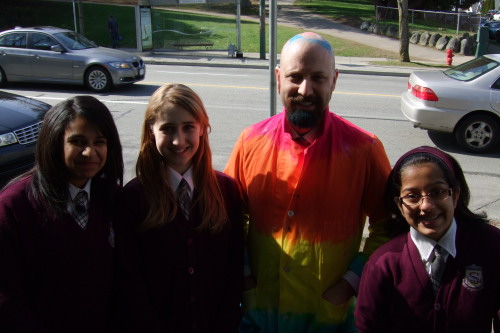I’m reading Don Tapscott’s and Anthony Williams’ "Wikinomics: How Mass Collaboration Changes Everything"[1] for the first time, and loving it. In the book, Tapscott and Williams focus a lot of their examples on the ways businesses are changing rather than on how teachers are adapting. I thought it would be appropriate to list some ways teachers are participating in the new mass collaboration culture.
First, it’s important to note that as a profession, teachers have always had collaboration, all that has changed is the scale of the collaboration. Rather than collaboration within a school, teacher’s are now collaborating on a global scale[2][3]. Teachers collaborate to build curriculum, write textbooks, examine student work, build lesson plans, investigate issues related to school improvement, all of this with other like-minded educators from across the planet, all on a scale not seen before.
Collaborative curriculum and textbook writing is changing the way educators gather their resources. Connexions is "an environment for collaboratively developing, freely sharing, and rapidly publishing scholarly content on the Web." according to their about page. It is more than that though, because of the way the site is structured[4][5][6]. Anyone can download the publicly accessible textbooks from their site, and can ask permission to join any open projects because the materials are licensed under a Creative Commons attribution license. The site is very successful with 16141 modules developed as of the writing of this post. Each module is equivalent to a unit of study in a course, so there already many more modules available than the typical student will ever learn in the course of their lifetime. Even the state of California has joined in on the action, estimating that they will save taxpayers $350 million by choosing open textbooks.
Teachers have also been forming their own social networks. Classroom 2.0, EduPLN, and other similar regional social networks have sprung up as teachers recognize the value in a diverse set of opinions on education. Rather than being closeted in the isolation of their individual classrooms, teachers are meeting virtually with other educators in order to improve their practice. On a weekly basis on the social networking site, Twitter[7], teachers have been chatting on a wide range of topics, using the hashtag #edchat to manage their conversations. Less formally, teachers are collaborating on the site in smaller groups, and finding interesting uses for the microblogging site in their classrooms[8].
This new form of mass collaboration between teachers is crucial for our survival as a profession, given the rate at which knowledge is growing[9]. Our ability, in small groups or as individuals, to process the information available to us is limited and as a result, we will soon no longer be able to choose the most appropriate curriculum for our students because the amount of information to sift through is too much. Working on the large scale, in peer groups, we may have a chance to avert this fundamental crisis in education as each member can contribute to the solution, allowing for a much wider range of information to be processed. Essentially peer collaboration allows teachers to work in networks and increase their individual efficiency, much like networking computers increases their computational power.
References:
1. Tapscott, D. & Williams, A. (2008). Wikinomics: How mass collaboration changes everything from Portfolio Trade
2. Riel, M. (1995). Cross-classroom collaboration in global learning circles, The cultures of computing, Wiley-Blackwell, 1995, 219-242, retrieved from Google books on March 28th, 2010.
3. Zong, G. Developing preservice teachers’ global understanding through computer-mediated communication technology, Teaching and Teacher Education, Elsevier, 2009, 25, 617-625
4. Baker, J.; Thierstein, J.; Fletcher, K.; Kaur, M. & Emmons, J. (2009). Open Textbook Proof-of-Concept via Connexions, The International Review of Research in Open and Distance Learning, 10, retrieved from Google Scholar on March 29, 2009
5. Frydenberg, J.; Matkin, G. & Center, D. (2007). Open textbooks: Why? What? How? When?, William and Flora Hewlett Foundation, retrieved from http://www.uensd.org/NUTN2008/program/Sessions/materials/OpenCouseware_paper.pdf on March 28th, 2010.
6. Hylén, J. (2006). Open educational resources: Opportunities and challenges, Proceedings of Open Education, 49-63, retrieved from http://pascal.iseg.utl.pt/~ssantos/Blog_Recursos_Varios.pdf on March 28th, 2010
7. O’Reilly, T. & Milstein, S. (2009). The Twitter Book O’Reilly Media, Inc., retrieved from Google Books on March 28th, 2010
8. Grosseck, G. & Holotescu, C. (2008). Can we use Twitter for educational activities, 4th International Scientific Conference, eLearning and Software for Education, Bucharest, Romania, retrieved from http://adlunap.ro/eLSE_publications/papers/2008/015.-697.1.Grosseck%20Gabriela-Can%20we%20use.pdf on March 28th, 2010
9. Kurzweil, R. (2001), The Law of Accelerating Returns, published on KurzweilAI.net, retrieved from http://www.kurzweilai.net/articles/art0134.html?printable=1 on March 28th, 2010

 Just recently we had a very different type of auction at our school. Some teachers and many of the 12th grade students auctioned off various services for charity. For example, one of my colleagues agreed to dress up in drag and take some kids for an ice cream. Another pair agreed to set up a pizza lunch for the kids. The funds at the end of the event are going to our global humanitarian fund.
Just recently we had a very different type of auction at our school. Some teachers and many of the 12th grade students auctioned off various services for charity. For example, one of my colleagues agreed to dress up in drag and take some kids for an ice cream. Another pair agreed to set up a pizza lunch for the kids. The funds at the end of the event are going to our global humanitarian fund.